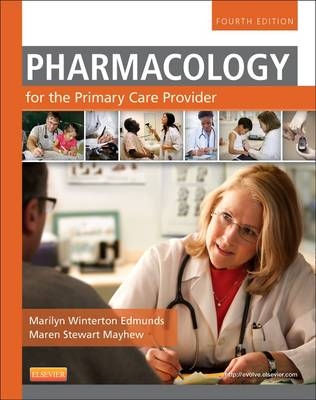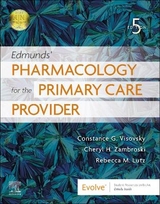
Pharmacology for the Primary Care Provider
Mosby (Verlag)
978-0-323-08790-2 (ISBN)
- Titel erscheint in neuer Auflage
- Artikel merken
Written by and for nurse practitioners, and also well suited for physician's assistant students, this practical textbook focuses on what primary care providers need to know in order practice safe and effective drug therapy. With an overall emphasis on patient teaching and health promotion, Edmunds & Mayhew teaches students and practitioners how to provide effective patient teaching about medications and how to promote adherence to prescribed drug regimens. Drug coverage focuses on "key drugs" - those most commonly used and most representative of each major drug class - with particular emphasis on the top 100 most commonly prescribed drugs. The book also features integrated coverage of nationally accepted clinical and evidence-based practice guidelines. The new 4th edition features a completely new full-color design and illustration program;; coverage of new drugs, new drug classes, and new therapeutic drug uses; updated coverage of the latest national clinical and evidence-based treatment guidelines; newly integrated and highlighted coverage of drug-herb interactions; an expanded emphasis on safety and evidence-based practice, consistent with the QSEN initiative, retooled "Safety Alert!" and "Clinical Practice Alert!" highlights; expanded and an enhanced ancillary package emphasizing graduate-level QSEN KSAs and new pharmacology-focused ArchieMD animations.
A Key Drugs focus highlights the most commonly used and most representative drugs of each major drug class - with particular emphasis on the top 100 most commonly prescribed drugs.
Emphasis on patient teaching helps you communicate with patients and family caregivers to promote adherence to the drug regimen.
Emphasis on health promotion describes how to help patients stay well and improve their health, including coverage of immunizations and biologicals, vitamins, weight management, and smoking cessation.
Evidence-Based Decision-Making and Treatment Guidelines chapter (11) provides practical guidelines for using the best current research evidence to make decisions about the care of individual patients.
Extensive coverage of drug therapy for special populations such as geriatric and pediatric patients includes considerations related to age, pregnancy, race, and other factors.
UNIQUE! Coverage of prescriptive practice includes topics such as prescriptive authority, role implementation, and the role of nurses (NPs, CNMs, CRNAs, and CNSs) and physician assistants in writing prescriptions.
NEW! Full-color design and illustrations highlight the most important content.
DRUG UPDATES reflect the latest FDA-approved drugs, drug classes, and therapeutic uses.
Expanded emphasis on the QSEN priorities of safety and evidence-based practice helps you eliminate drug prescribing errors with color-highlighted Safety Alerts! and NEW Clinical Practice Alerts!
NEW section on male hormone replacement therapies adds coverage of men to that for women.
Updated evidence-based prescribing information reflects the latest national clinical practice guidelines and evidence-based treatment guidelines, including the latest clinical treatment guidelines for diabetes.
NEW! Complementary and Alternative Products tables highlight interactions with drugs, and are emphasized with a distinctive icon.
Updated Drug Overview tables are enhanced with color as well as Top 100 icons that highlight the most commonly prescribed drugs.
Edmunds & Mayhew: Pharmacology for the Primary Care Provider, 4th edition
TOC
PART ONE - ESSENTIAL CONCEPTS FOR THE PRESCRIPTION OF MEDICATIONS
Unit 1 Foundations of Prescriptive Practice Ch. 1 Prescriptive Authority and Role Implementation: Tradition vs. Change Ch. 2 Historical Review of Prescriptive Authority: The Role of Nurses (NPs, CNMs, CRNAs, and CNSs) and Physician Assistants
Unit 2 Pharmacokinetics and Pharmacodynamics Ch. 3 General Pharmacokinetic and Pharmacodynamic Principles Ch. 4 Special Populations: Geriatrics Ch. 5 Special Populations: Pediatrics Ch. 6 Special Populations: Pregnant and Nursing Women Ch. 7 Over-the-Counter Medications Ch. 8 Complementary and Alternative Therapies
Unit 3 The Art and Science of Pharmacotherapeutics Ch. 9 Establishing the Therapeutic Relationship Ch.10 Practical Tips on Writing Prescriptions Ch.11 Evidence-Based Decision-Making and Treatment Guidelines Ch.12 Design and Implementation of Patient Education
PART TWO - DRUG MONOGRAPHS
Unit 4 Topical Agents Ch. 13 Dermatologic Agents Ch. 14 Eye, Ear, Throat, and Mouth Agents
Unit 5 Respiratory Agents Ch. 15 Upper Respiratory Agents Ch. 16 Asthma and Chronic Obstructive Pulmonary Disease Medications
Unit 6 Cardiovascular Agents Ch. 17 Hypertension and Miscellaneous Antihypertensive Medications Ch. 18 Coronary Artery Disease and Antianginal Medications Ch. 19 Heart Failure and Digoxin Ch. 20 ß-Blockers Ch. 21 Calcium Channel Blockers Ch. 22 ACE Inhibitors and Angiotensin Receptor Blockers Ch. 23 Antiarrhythmic Agents Ch. 24 Antihyperlipidemic Agents Ch. 25 Agents that Act on Blood
Unit 7 Gastrointestinal Agents Ch. 26 Antacids and the Management of GERD Ch. 27 Histamine2- Blockers and Proton Pump Inhibitors Ch. 28 Laxatives Ch. 29 Antidiarrheals Ch. 30 Antiemetics Ch. 31 Medications for Irritable Bowel Syndrome and Other Gastrointestinal Problems
Unit 8 Renal/Genitourinary Agents Ch. 32 Diuretics Ch. 33 Male Genitourinary Agents Ch. 34 Drugs for Urinary Incontinence and Urinary Analgesia
Unit 9 Musculoskeletal Agents Ch. 35 Acetaminophen Ch. 36 Aspirin and Nonsteroidal Antiinflammatory Medications Ch. 37 Disease-Modifying Antirheumatic Drugs and Immune Modulators Ch. 38 Gout Medications Ch. 39 Osteoporosis Treatment Ch. 40 Muscle Relaxants
Unit 10 Central Nervous System Agents Ch. 41 Medications for Attention Deficit/Hyperactivity Disorder Ch. 42 Medications for Dementia Ch. 43 Analgesia and Pain Management Ch. 44 Migraine Medications Ch. 45 Antiepileptics Ch. 46 Antiparkinson Agents
Unit 11 Psychotropic Agents Ch. 47 Antidepressants Ch. 48 Antianxiety and Antiinsomnia Agents Ch. 49 Antipsychotics Ch. 50 Substance Abuse
Unit 12 Endocrine Agents Ch. 52 Glucocorticoids Ch. 52 Thyroid Medications Ch. 53 Diabetes Mellitus Agents
Unit 13 Reproductive System Medications Ch. 54 Contraceptives Ch. 55 Hormone Replacement Therapy Ch. 56 Drugs for Breast Cancer
Unit 14 Antiinfectives Ch. 57 Principles for Prescribing Antiinfectives Ch. 58 Treatment of Specific Infections and Miscellaneous Antibiotics Ch. 59 Penicillins Ch. 60 Cephalosporins Ch. 61 Tetracyclines Ch. 62 Macrolides Ch. 63 Fluoroquinolones Ch. 64 Aminoglycosides Ch. 65 Sulfonamides Ch. 66 Antitubercular Agents Ch. 67 Antifungals Ch. 68 Antiretroviral Medications Ch. 69 Antiviral and Antiprotozoal Agents
Unit 15 Health Promotion Ch. 70 The Immune System and Immunizations Ch. 71 Weight Management Ch. 72 Smoking Cessation Ch. 73 Vitamins and Minerals
| Zusatzinfo | Approx. 156 illustrations (156 in full color); Illustrations |
|---|---|
| Verlagsort | St Louis |
| Sprache | englisch |
| Maße | 216 x 276 mm |
| Gewicht | 1733 g |
| Themenwelt | Schulbuch / Wörterbuch ► Lexikon / Chroniken |
| Medizin / Pharmazie ► Medizinische Fachgebiete ► Pharmakologie / Pharmakotherapie | |
| Medizin / Pharmazie ► Pflege ► Ausbildung / Prüfung | |
| ISBN-10 | 0-323-08790-6 / 0323087906 |
| ISBN-13 | 978-0-323-08790-2 / 9780323087902 |
| Zustand | Neuware |
| Haben Sie eine Frage zum Produkt? |
aus dem Bereich



